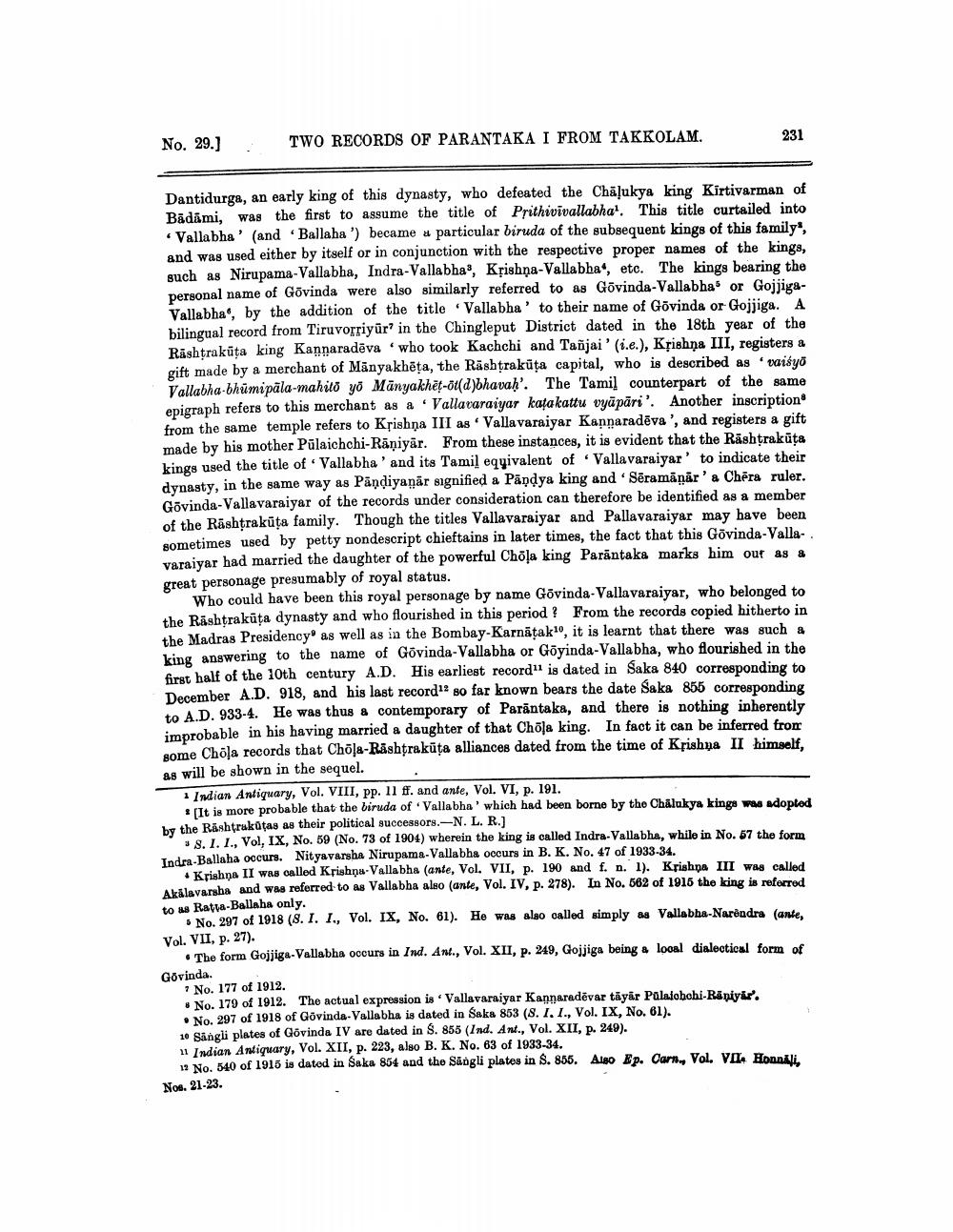________________
No. 29.)
TWO RECORDS OF PARANTAKA I FROM TAKKOLAM.
231
Dantidurga, an early king of this dynasty, who defeated the Chāļukya king Kirtivarman of Badāmi, was the first to assume the title of Prithivivallabha'. This title curtailed into . Vallabha' (and Ballaha') became a particular biruda of the subsequent kings of this family, and was used either by itself or in conjunction with the respective proper names of the kings, such as Nirupama-Vallabha, Indra-Vallabha, Krishna-Vallabha', etc. The kings bearing the personal name of Govinda were also similarly referred to as Govinda-Vallabha' or GojjigaVallabha', by the addition of the title Vallabha' to their name of Govinda or Gojjiga. A bilingual record from Tiruvorriyür' in the Chingleput District dated in the 18th year of the Rashtrakūta king Kannaradēva 'who took Kachchi and Tañjai' (i.e.), Křishna III, registers a gift made by a merchant of Mänyakhēta, the Rashtrakūta capital, who is described as "vaisyo Vallabha bhūmipāla-mahito yo Mänyakhet-ot(d)bhavah'. The Tamil counterpart of the same epigraph refers to this merchant as a Vallavaraiyar kata kattu vyāpāri'. Another inscription from the same temple refers to Krishna III as. Vallavaraiyar Kannaradēva ', and registers a gift made by his mother Pūlaichchi-Rāniyār. From these instances, it is evident that the Rashtrakūta kings used the title of Vallabha' and its Tamil equivalent of Vallavaraiyar' to indicate their dynasty, in the same way as Pandiyanār signified a Pandya king and Sēramänär'a Chëra ruler. Govinda-Vallavaraiyar of the records under consideration can therefore be identified as a member of the Rashtrakūta family. Though the titles Vallavaraiyar and Pallavaraiyar may have been sometimes used by petty nondescript chieftains in later times, the fact that this Govinda-VallaVaraiyar had married the daughter of the powerful Chola king Parantaka marks him out as a great personage presumably of royal status.
Who could have been this royal personage by name Govinda-Vallavaraiyar, who belonged to the Rashtrakūta dynasty and who flourished in this period ? From the records copied hitherto in the Madras Presidency as well as in the Bombay-Karnatak, it is learnt that there was such & king answering to the name of Govinda-Vallabha or Göyinda-Vallabha, who flourished in the first half of the 10th century A.D. His earliest record is dated in Saka 840 corresponding to December A.D. 918, and his last record so far known bears the date Saka 855 corresponding to A.D. 933-4. He was thus & contemporary of Parāntaka, and there is nothing inherently improbable in his having married a daughter of that Chola king. In fact it can be inferred from some Chola records that Chola-Rashtrakūta alliances dated from the time of Krishna II himself, as will be shown in the sequel. 1 Indian Antiquary, Vol. VIII, pp. 11 ff. and ante, Vol. VI, p. 191.
It is more probable that the biruda of Vallabha' which had been borne by the Chalukya kinge was adopted by the Rashtrukātas as their political successors.-N. L. R.)
38. 1. 1., Vol. IX, No. 59 (No. 73 of 1904) wherein the king is called Indra-Vallabha, while in No. 67 the form Indra.Ballaha occurs. Nityavarsha Nirupama-Vallabha occurs in B. K. No. 47 of 1933-34.
+ Krishna II was called Krishna-Vallabha (ante, Vol. VII, p. 190 and f. n. 1). Krishna III was called Akalavarsha and was referred to as Vallabha also (ante, Vol. IV, p. 278). In No. 562 of 1915 the king is referred to us Ratta-Ballaba only.
No. 297 of 1918 (8. I. I., Vol. IX, No. 61). He was also called simply as Vallabha-Narendra (ante, Vol. VII, p. 27).
• The form Gojjiga-Vallabha occurs in Ind. Ant., Vol. XII, p. 249, Gojjiga being a local dialectical form of Govinda.
No. 177 of 1912. • No. 179 of 1912. The actual expression is Vallavaraiyar Kannaradevar tāyar Palaiochi-Raniyir. • No. 297 of 1918 of Govinda-Vallabha is dated in Saka 863 (8. I, I., Vol. IX, No. 61). 10 Sångli plates of Govinda IV are dated in S. 855 (Ind. Ant., Vol. XII, p. 249). 11 Indian Antiquary, Vol. XII, p. 223, also B. K. No. 63 of 1933-34.
12 No. 540 of 1915 is datod in Saka 854 and the Sangli plates in S. 836. Also Ep. Carn., Vol. VIL Honnali. Nos. 21-23.




